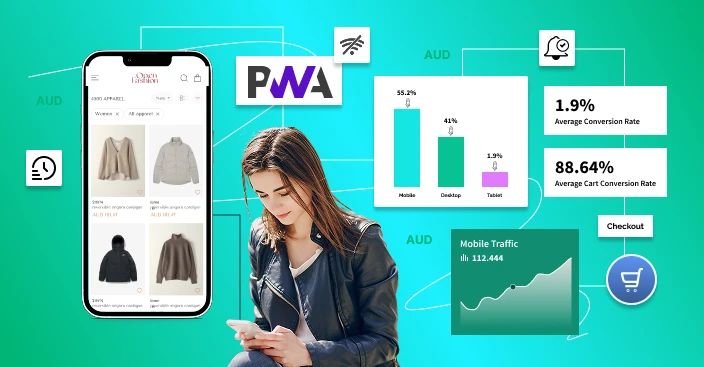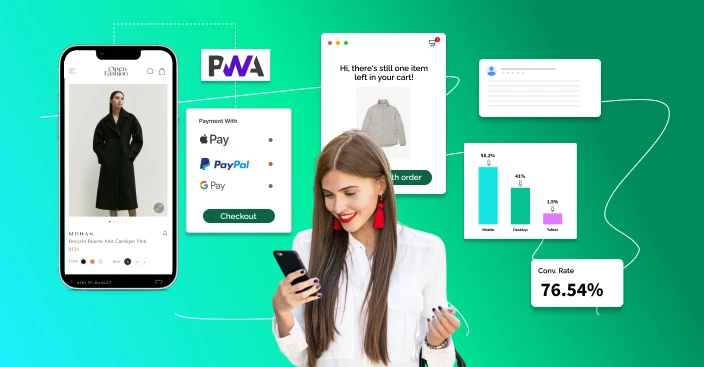How PWAs Increase Mobile Conversions for Australian eCommerce Brands

Table of Contents
The Australian eCommerce market has witnessed unparalleled growth over the past couple of years, driven by accelerating smartphone penetration, contactless payments, and shifting consumer behaviour.
Online revenues have grown over 10% year-on-year, with mobile commerce contributing significantly, according to the Australia Post eCommerce Industry Report 2024.
Yet, the majority of Australian retailers still battle mobile conversions. The most common issues are slow websites, complex navigation, and lengthy checkouts, typically due to abandoned carts.
With the help of Progressive Web Apps (PWAs), these issues can be addressed and reduced, as these mergers can help to grow the web speed with native app performance.
This blog explains how PWAs assist Australian retailers in boosting mobile conversions, why they are perfectly adapted to the local environment, real success stories, and actionable steps.
Understanding PWAs in the Context of Australia
A Progressive Web App (PWA) refers to a web application that is based on innovative technology and that behaves like a native app.
In contrast to the traditional apps, no need for PWAs to be downloaded from the app stores. One can access them using a browser and tap to save it on the home screen.
To Australian shoppers, who value speed, ease, and frictionless experiences, PWAs address some of the most significant mobile shopping issues:
- Lightning speeds in remote or regional areas with poor connectivity.
- Zero downloading, instant and easy access.
- Push notifications to remind customers and avoid cart abandonment.
- App-like features with the cost of individual iOS and Android apps.
Why Mobile Conversions Matter to Australian eCommerce
Mobile rules Australian online retail. Australians shop and buy online on smartphones more than 74%. With incredible mobile traffic, however, mobile conversion lags behind desktop due to:
Frustration from slow site-load.
- Malnavigated mobile sites resulting in drop-offs.
- Complicated checkouts are causing cart abandonment.
PWAs fill this gap with instant app-like experiences, taking customers to buy and drive mobile conversions.
Principal Benefits of PWAs for Aussie eCommerce Websites
Rapid Loading Speeds
Rapidly loading websites is crucial in Australia, especially in rural areas where cell phone reception is poor.
PWAs utilise caching and service workers to enable rapid loading. Research has shown that even a reduction in speed by one second reduces conversions by up to 20%, and hence speed is critical in creating mobile commerce.
Increased User Engagement
PWAs enable brands to re-engage consumers through push notifications and offer discounts.
Australian retailers can remind consumers about offers, restocking, or releases and constantly engage them.
With context-targeted and timely messages, PWAs create engagement, prevent cart abandonment, and ensure repeat buying, generating more mobile-led revenue.
Offline Access
The majority of Australians live in rural areas with patchy internet coverage. PWAs allow customers to view products, place products in a cart, and purchase products offline.
Offline availability increases accessibility, offers seamless shopping experiences irrespective of the location anywhere in the country, and allows brands to tap into revenues where they were previously unreached.
Cost-Effective Development
Native Android and iOS application development is expensive. PWAs enable businesses in Australia to invest money in a single solution that will work on any device, instead of development costs and maintenance.
Since it is cost-effective, businesses can invest money in expansion tactics but still deliver an excellent quality mobile experience.
Better Conversion Rates
Global case studies like AliExpress experienced a new user conversion rate increase of 104% after rolling out a PWA.
Australian businesses can similarly gain with a faster, more reliable mobile experience, converting occasional browsers into customers.
PWAs Success Stories in eCommerce
While giants of the world like Alibaba and amazon have already taken advantage of PWAs, Australian businesses are also following in their footsteps to drive a better mobile shopping experience:
Kogan
Kogan is the most reliable and largest Australian online retailer, and has used PWA-driven initiatives to ensure faster and more efficient mobile shopping.
It’s eventually helped them to reduce the page load times, streamlining checkout processes, and achieving cross-platform performance optimisation has helped Kogan.com improve conversion in the metro and rural markets.
Its mobile-first approach addresses rising consumer expectations and provides a smooth, app-like web experience for Australian shoppers.
Big W
Big W, Australia’s big retailer, has embraced PWA-type features to streamline mobile commerce.
Strategies encompass faster navigation, fewer checkout workflows, and offline capability, allowing customers to shop and purchase without disruption.
Such features have reduced cart abandonment, enhanced repeat purchase, and married Big W’s competitive advantage in Australia’s retail market, producing measurable increases in mobile conversions.
Below are some of the ways in which Australian companies are using PWAs to beat competitors, provide improved user experiences, and achieve maximum mobile conversions.
How PWAs Specifically Facilitate Conversions
Simplified Checkout
PWAs reduce friction by making one-click payments, such as Google Pay, Apple Pay, and PayPal, easy.
Easy checkout reduces cart abandonment and encourages customers to buy. Faster, more seamless checkouts also increase customer satisfaction and loyalty, and correlate directly with mobile conversion rates.
Personalisation Amplified
PWAs allow businesses to provide a personalised experience depending on the way the customer is browsing.
Discount promotions, back-in-stock alerts, and recommendation lists make the customer feel privileged.
Reaching the right person at the right time with the right content drives purchasing intent and installs repeat purchasing behaviour.

Cross-Device Consistency
Customers prefer jumping from device to shop. With the help of PWAs, brands can ensure a seamless user experience across all devices, for reducing drop-offs and building trust. Seamless device browsing generates trust and leads people to purchase, thus converting.
SEO Benefits
In a way, as opposed to native apps, PWAs can be crawled by search engines, promoting organic visibility.
Greater discoverability will lead to more high-quality traffic, while mobile-first optimisation ensures that it is simple to find and engage with products by consumers. Together, this boosts traffic alongside the potential for search-driven conversion.
The Australian Shopper Mindset
Mobile-First Shopping
Over 55% of Australians use mobile to access the internet and make purchases. They expect an easy-to-use design, fast loading, and hassle-free checkout; not meeting these can create dissatisfaction.
With the help of PWAs, app-like mobile experiences can be delivered to the end-users, which will help brands turn traffic into sales and higher satisfaction by reducing the issue of slow or clumsy sites, making them ideal for mobile-first consumers.
High Expectations
Australian consumers want easy, safe, and convenient shopping. Navigation and avoidance failure would lead to abandonment.
PWAs deliver all such speed performance requirements, responsive design, and easy checkout procedures, increasing customer satisfaction, engagement, and mobile conversions.
Regional Inclusivity
Since over 8 million Australians live in rural areas, there cannot always be connectivity. PWAs facilitate offline, where shoppers are able to browse products and make a purchase even during periods of low internet speed.
This accommodation allows market coverage as well as generates turnover from historically underpenetrated markets, and makes mobile commerce possible in the whole country.
Sustainability Focus
Australian consumers are increasingly asking for greenness and efficiency, or less data consumption.
PWAs consume less bandwidth than their native counterparts, a trend that is indicative of consumer preference for lean, green technology.
Facilitating instant-launching, lightweight experiences enhances user retention and the building of loyalty and indirectly enhances conversion rates.
Challenges and Considerations for Australian Brands
Awareness and Adoption
Australian retailers do not know the advantages of PWA. They must be informed of its strengths, possible ROI, and effects on mobile conversion.
If these benefits are unknown, companies won’t implement and miss out on the chance to accelerate the mobile shopping experience and improve top-line growth.
iOS Limitations
Apple does support PWAs, but with some limitations, like limited push notifications and offline functionality. iOS PWAs will need to be thoroughly tested and fine-tuned by merchants in terms of performance in order to maintain pace.
Such platform-specific limitations can be best foreseen so that smooth experiences on Android and iOS become a reality, ruling out any chance of disillusionment for the users.
Initial Investment
Development of PWA requires initial investment in design, development, and testing. A future ROI in the guise of increased conversions, increased engagement, and decreased maintenance compared to developing native apps separately equalised the investment. Strategic planning in its true form enables optimum return on investment.
Australian Retailers’ Move towards Embracing PWAs
Conduct Existing Mobile Experience Audit
Begin by checking website speed, interaction, and conversion rate. Identify pain areas such as slow download, navigation, or cart abandonment.
This test provides a tangible roadmap to PWA optimisation and ensures that technology aligns with your audience’s needs suitably.
Identify Business Goals
Establish concrete objectives for your PWA. Are you looking to reduce cart abandonment, drive repeat orders, expand geographic presence, or drive mobile engagement?
Clear goals allow you to establish success and ensure strategic alignment of the PWA with business objectives, driving mobile conversion to the fullest.
Choose the right technology partner
Engage with established PWA developers who have technology and Australian market experience.
A good partner will lead on deployment, enable integration with legacy infrastructure, and optimise for performance, speed, and cross-device consumption to deliver a quality mobile experience.

Test and Optimise Continuously
Launch the PWA progressively, capture user feedback, and measure engagement and conversion rates.
Continuous testing and optimisation allow the PWA to evolve along evolving user expectations, respond to shifts in mobile behaviour, and optimise performance, allowing continuous conversion rate optimisation.
Mark Your PWA
Drive adoption by reminding users about the “Add to Home Screen” feature, offering them special offers, and prompting through email, social media, and in-store promotions.
Promotion reminds users aggressively about the worth of the PWA, thus driving increased engagement and mobile conversions.
Future of PWAs in Australian eCommerce
Since mobile shopping has become the new standard, PWAs will become mainstream in Australia in a snap.
By 2026, more than half of all Australian brands are planning to adopt PWAs. With the early adoption, there can be a better outcome for them in terms of mobile conversions, better engagement, and growing loyalty, which will later create a mobile-first eCommerce upgrade for the Aussies brands.
Conclusion
Australian e-commerce businesses must bridge the conversion gap with mobile traffic. PWAs build instant, reliable, and interactive experiences that induce checkout, personalisation, and cross-device adoption.
Being a performance boost to offline, PWAs transform the mobile browser into your repeat customer.
For Australian retailers, an investment in PWA is a strategic move towards greater revenues, customer satisfaction, and sustainable growth. Connect with an expert for better implementation.
FAQs
 What is the major benefit of PWAs for Australian eCommerce businesses?
What is the major benefit of PWAs for Australian eCommerce businesses?
PWAs increase mobile conversion rates with instant, secure, and app-like shopping without install
 Are PWAs better than native apps for Australian retailers?
Are PWAs better than native apps for Australian retailers?
Yes. PWAs are cheap, easy to maintain, and offer the same experience on both platforms, thus perfectly fit for Australian businesses.
 Do PWAs work offline in rural towns in Australia?
Do PWAs work offline in rural towns in Australia?
Yes. PWAs enable offline cart and browsing, which are most useful for consumers in areas where there is poor internet connectivity.
 How can Australian retailers help customers access their PWA?
How can Australian retailers help customers access their PWA?
Inform the customer about the “Add to Home Screen” function, provide rewards, and market it via newsletters, online platforms, and retail promotions.



